Mystery of the Wax Museum (1933)
Directed by: Michael Curtiz
Written by: Carl Erickson, Charles Belden, Don Mullaly
Starring: Fay Wray, Frank McHugh, Glenda Farrell, Lionel Atwill
USA
AVAILABLE ON BLU-RAY [REGION A], DVD, and DIGITAL [REGION A]
RUNNING TIME: 83 mins
REVIEWED BY: Dr Lenera
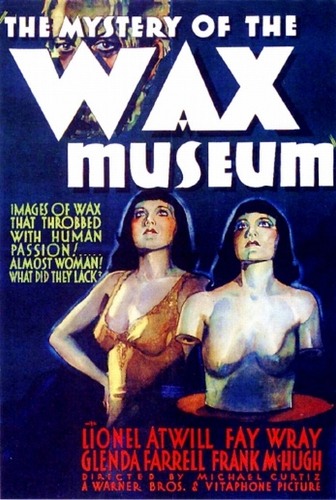
London 1921; sculptor Ivan Igor operates a wax museum which specialises in historical figures. Business is failing, so Igor’s business partner Joe Worth starts a fire, knocks Ivan out and leaves him to die so Joe can get insurance money from the place burning down. Ivan reemerges twelve years later in New York City, with a new wax museum about to open, though he must rely on assistants to create the sculptures as his hands and legs were badly burnt. Meanwhile, spunky reporter Florence Dempsey, on the verge of being fired for not bringing in any worthwhile news, is sent by her editor, Jim, to investigate the suicide of a model named Joan Gale. A hideous monster steals the body from the morgue. The finger initially points to George Winton, son of a powerful industrialist, but Florence thinks differently….
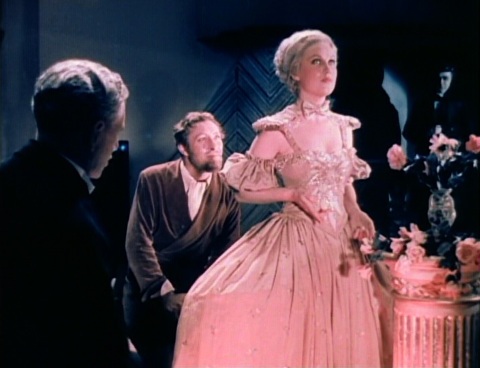
I reviewed Mystery Of the Wax Museum in the very early days of HCF, but seeing as I tend to have so much to waffle on these days, and that I’m doing write-ups of the six films in the Hollywood Legends Of Horror DVD set which comprise most of the horror films made by Warner Bros. and MGM in the 1930’s, I decided to revisit a film which is quite fascinating and is a pretty well balanced mixture of mystery, police procedural, wise-cracking newspaper comedy and horror, though it’s also one that I’ve never quite warmed to as much as I probably should despite its entertainment value and its artistry. In fact – and some readers may kill me for saying this – I tend to prefer the 1953 remake House Of Wax, even if I’m not sure that it’s as good a film overall. I guess that statement makes little sense, but in any case, seeing as for some strange reason I’m finding myself with a lot of time on my hands these days, I decided to rewatch and review that movie too and post my review of that as a companion piece to my review of this one, which is very similar to the previous year’s Doctor X and involved many of the same cast and crew, including actors Lionel Atwill, Fay Wray, Arthur Edmund Carewe and Thomas Jackson; director Michael Curtiz; art director Anton Grot; and cameraman Ray Rennahan. It even re-uses Doctor X‘s opening theme music by Bernhard Kaun. In some ways it tops the previous work, though in some ways it doesn’t, and actually contains a smaller percentage of horror which may disappoint some viewers. Nonetheless, from its striking sets to its pre-code aspects, there’s a lot to interest and appreciate.
It was based on an unpublished short story, “The Wax Works”, by Charles S. Belden, who’d also written a similar play called “The Wax Museum”, which had been optioned by independent producer Charles Rogers, though Roger dropped his option on the latter when threatened with a lawsuit from the co-author of a Broadway play with a similar plot. As with Doctor X, this was filmed in two-colour Technicolor, but the combination of the public not being enthralled with the process and the Technicolor company being angry at Warners for violating their contract by filming Doctor X with an additional black and white unit, meant that this would be the last film to be shot this way. The extremely bright light required for filming under the Technicolor process melted some of the wax figures, requiring most of them to be played by actors. The big unmasking scene had Fay Wray hitting the prop mask a couple of times and some of it failing to come off, so she just pulled off what remained of the mask as it was the only way to make the scene work. As before, cast and crew weren’t much keen on Curtiz’s dictatorial direction and intimidating attitude. Tne film did well at the box office though European grosses exceeded domestic ones. Never reissued in cinemas, it became a lost film. A print was found in 1947 at Warners’ London exchange though was decaying so badly it was destroyed. In 1970 the Warner Bros. studio reference print was found in former studio head Jack Warner’s personal collection, though revival and TV copies had little of the original colour. Last year’s digital restoration also used material from a French workprint.
We begin in rain-soaked London and a nice pan around the inside of Ivan’s wax museum to reveal Ivan at work. Ivan seems a little eccentric as he chats to his dummies and has a real fondness for Marie Antoniette his “masterpiece” but still sympathetic. He gives a private tour to a friend and an investor who offers to submit Igor’s work to the Royal Academy. Unfortunately business is failing due to people’s attraction to the macabre which another nearby wax museum caters to, but Igor doesn’t want to stoop to that sort of thing. His partner Joe Worth starts a fire for the insurance and during the reasonable fight that ensues we’re treated to plenty of shots of the mannequins melting with emphasis on the faces, the different stages of from the first running of the wax to heads falling off lingered upon in a pretty gruesome manner for the time. As it seems like Igor will perish in the inferno, we cut to New Year’s Day celebrations in New York City twelve years later. A suicide is being carted out of a block of apartments into a sea of revelers, and we glimpse plenty of the latter inside through windows too, plus an older Ivan, watching the scene below. Cut to a morgue and a great bit of comedy becoming horror when the two assistants are spooked by the body of a woman murdered by her husband for “talking too much” sitting up, supposedly due to effects of the embalming fluid, and one of the men says” isn’t that typical of women, always got to have the last word”. Then, when the men have gone, another body sits up revealing a hideously deformed figure who starts to stalk around checking the corpses in a virtually silent moment of great creepy atmosphere, before he and some others lower a body out of a window, this being the eighth body that’s been stolen in a year and a half in the city.
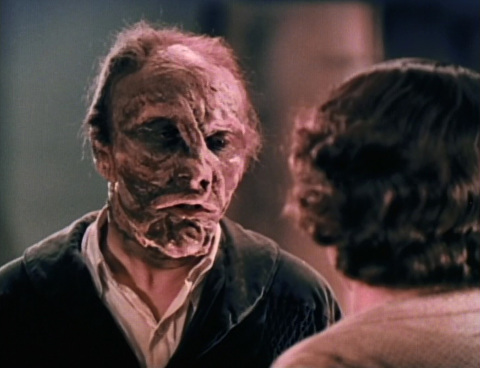
Doctor X introduced us to its [supposedly] funny ‘hero’ almost right from the offset, but this film only does this around fifteen minutes in. Florence is on the verge of losing her job, but quickly realises that the police’s suspect rich boy George Winton isn’t responsible for the disappearance of the body and possibly murder too. Her roommate is Charlotte Duncan, whose fiancée Ralph works at Igor’s new wax museum which is about to open to the public. While there, Florence notices an uncanny resemblance between a wax figure of Joan of Arc and the dead model. At the same time, Igor spots Charlotte and remarks on her resemblance to his sculpture of Marie Antoinette – and even if you haven’t seen this film before you’ll be able to predict where things are going. Would 1933 audiences have been surprised? Possibly. Apart from a tremendously tense moment with Charlotte hiding from the monster, and a few creepy images like a human’s face appearing among wax faces that are on a table, there isn’t really any more horror until the final act set in Ivan’s laboratory which is wonderfully expressionistic with its bizarrely-lit corridors, staircases that seem to be in the wrong place, and concrete and steel waxing structure. Production designer Anton Grot again does a great job while being able to recycle his sets from Doctor X. The climax is energetic with people leaping all over the place, though it’s very much a rehash of the one in the 1932 [reprised in the 1941] version of Dr Jekyll And Mr Hyde, and I do wonder if the filmmakers missed a beat by showing the makeup so early, even if it’s at a distance and only in three scenes? It would have made the climactic unmasking a la The Phantom Of The Opera even more effective, though would the revelation that Ivan is the monster really have been a surprise to 1933 audiences especially those who’d recently seen Doctor X? I wouldn’t have thought that it would be, but then again it’s sometimes hard to place oneself in the minds of cinemagoers many centuries back. That said, the makeup is very good and convincing.
The main thread of the plot is actually pretty thin, though things move well nonetheless despite the lack of many ‘thrill’ sequences. A surprising subplot that never would have made it in two years later fills in some of the rest of the running time. In addition to his two sculpting assistants whom he seems to have little opinion of, Ivan also employs the services of a deaf-mute named Hugo [the conditions of such a character were often crassly employed to frighten back then] and Professor Darcy, another sculptor but also a drug addict, who by the way also works for Joe, who’s become a bootlegger [with George one of his customers]. It’s not specified what drug it is, but it seems suspiciously like heroin. This poor guy is brutalised by both Joe and the interrogating police and is often shaking and desperate for a hit. Arthur Edmund Carewe is pretty convincing in the part though the fact that he killed himself only four years later adds an even grimmer feel. The irritating journalist character in Doctor X was the major thing that held back that film from becoming a genuine classic, but this one succeeds much better in this respect. Firstly, making the person into a woman freshens the idea and gives us a really forthright heroine for the time, a heroine who happily admits that money is the most important thing in a man, asks “how’s your sex life”? to a cop, and, upon finding a coffin packed with bootleg liquor, takes her share before the cops can take it all – which also bravely suggests open corruption in the police force. And secondly, she’s not given lots of unfunny ‘comedic’ beats to do, just some snappy repartee, especially with her editor Jim. She’s a flawed [“easy on the eyes and conceited about it”] heroine you nonetheless can’t not admire for her determination and bravery, and even seems pretty modern until her very conventional last scene. By contrast, Wray is underused, though her sparkling screen personality and subtle sexual presence are still able to shine.
While one is led to automatically think it’s Ivan, it’s actually never clear who’s doing all these murders made to look like suicides, and it’s possible that Ivan is only truly turning nasty at the end where, for once, he could be trying to place somebody in wax who’s still alive. Ivan’s allowed some surprising sympathy all the way through, and Atwill, rarely allowed to be this way when playing his innumerable villain roles, shows this very well. Some jokes cause at least a smile, lines like “we had nine or ten witnesses. No, they’re didn’t talk, they’re pretty stiff” after the latest morgue theft. Funny in an unintentional way is the fact that many of these dummies are played by real people is hugely obvious. In a few shots they don’t totally keep still and Queen Victoria even winks at the audience just before she’s burnt to death in a bit I used to wonder was intentionally comic though later changed my mind. I guess there wasn’t enough money left to have these bits redone. But on Blu-ray the colour looks fabulous, the green and red hues coming across much better than they did on the much older DVD of Doctor X, not to mention the murky way which this particular film used to look like. Greens predominate while reds are used sparingly, often just intruding into the frame a bit, and often diluted into pink. The particular pink hue of people’s faces hardly looks real, but then neither does anything else. Now properly restored, the restricted palette has a dream-like effect and even provides some genuine depth of field the way foregrounds tend to be dark – at times it’s almost like watching 3D. It’s now one of the most distinctive aspects of a minor near-classic which doesn’t totally hang together and which doesn’t seem to want to exploit the macabre elements of its story very much, though its genre blending brings its own rewards.
Rating: 











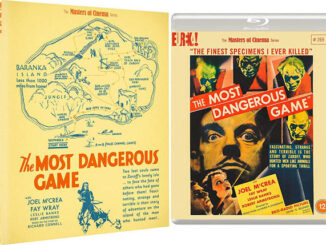
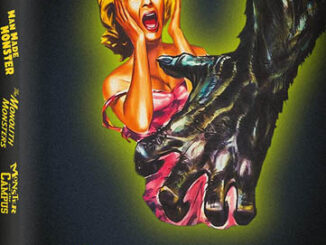
Be the first to comment